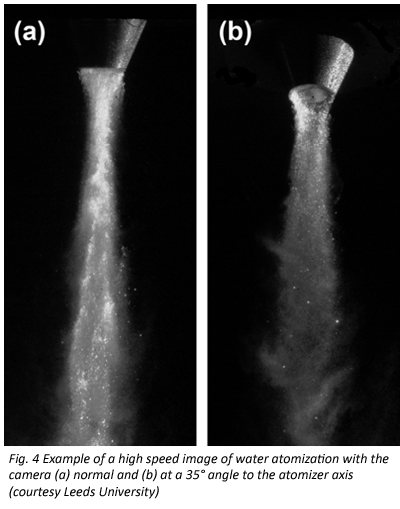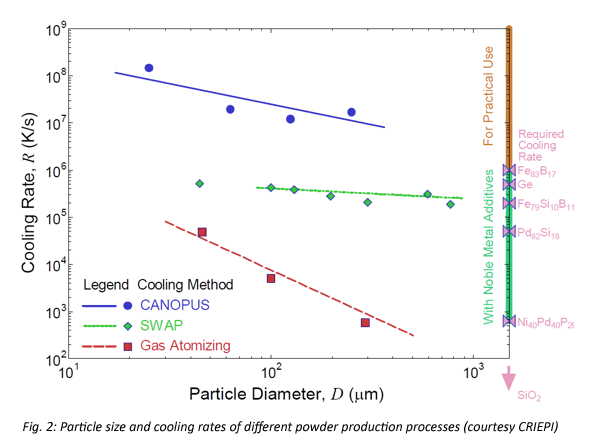Innovations in Powder Metallurgy at the PM2010 World Congress: Advances in Powder Production and Characterisation – Part 2
Dr Georg Schlieper focuses on a selection of papers for ipmd.net that highlight developments in this area.
Vapour explosion tamed
Fundamental innovations in powder production are rare. However, Dr Masahiro Furuya from the Central Research Institute of Electric Power Industry (CRIEPI) in Tokyo, Japan, presented an innovative method, the CANOPUS process, for the production of amorphous metal powders.
It is widely known that a drop of water on a hot plate does not evaporate immediately. A thin isolating layer of water vapour is formed at the interface and the drop “dances” on this vapour cushion, gradually reducing in size until all the water is vaporised.
Under certain conditions, however, water will be immediately vaporised when it comes into intimate contact with a hot molten metal. This phenomenon is known as vapour explosion. It has been regarded as an industrial disaster, since a catastrophic amount of mechanical energy is set free as a result of rapid vaporisation of a coolant contacting a molten alloy.

The Japanese researchers studied this phenomenon under controlled conditions and found a safe way to utilize it for the production of rapidly solidified metal powders. They injected a small stream of molten metal into a water stream and set the conditions so as to start a sustainable small-scale spontaneous vapour explosion. The water served simultaneously as a promoter of the vapour explosion and as a quenching agent. In this manner, they utilised vapour explosion securely and efficiently to produce a fine amorphous powder.
Based on the secondary dendrite arm spacing in Al89Si11 powders, the cooling rate of the CANOPUS process was estimated to be up to 1.5×108K/s which is 280 times higher than that of the SWAP process and even several thousand times higher than that of the widely used gas atomizing process (Fig. 2).
The CANOPUS process is very energy efficient as the energy required for atomising the melt is directly taken from the heat of the melt. It allows production of amorphous powders for materials with excellent high strength and ductility, corrosion resistance and soft magnetic properties.
High speed imaging techniques help optimise melt nozzle design
Research into melt atomisation technologies is stimulated by the increasing demand of ultra-fine spherical metal powders. Such powders have a variety of uses, such as in pigments, catalysts, fuel for solid-fuel rocket engines, metal injection moulding (MIM) and solder pastes for ‘flip-chip’ type circuit board fabrication.
Dr A M Mullis described how advanced high speed imaging techniques have been applied at the University of Leeds, United Kingdom, to study the correlation between the geometry of the melt nozzle and the melt and gas flow during close-coupled gas atomization (CCGA) with an analogue water atomiser.
The melt nozzle had an inner diameter of 2 mm and 18 gas jets arranged around it (Fig. 3a), and the tip of the nozzle was modified in three types, as shown in Fig. 3b. The gas inlet pressure was 20 bar. The researchers demonstrated that the width of the jet is directly related to the geometry of the melt nozzle. The high speed experiments were performed on an analogue water atomising nozzle.
The experimental techniques presented included a high frame rate video camera (18,000 fps) allowing to film a continuous sequence of images and a pulsed Nd:YAG laser to obtain pairs of still images with an incredibly short exposure time of 6 nanoseconds. By combining these techniques it was possible to demonstrate directly that the melt spray cone consists of a jet precessing around the surface of a cone and that the cone angle is influenced by the geometry of the nozzle.
An example of the high speed images taken with the experiment is shown in Fig. 4. It should be noted that the melt plume is asymmetric towards the axis of the nozzle. This is evidence of the precession movement of the jet. The evaluation of two sequential images with computer support allowed them to determine the moving direction and speed of individual particles in the melt plume. It demonstrated that an asymmetric recirculation eddy exists at the circumferential edge of the gas-melt interface in the primary atomisation zone. This eddy precesses around the jet axis as well.
Melt nozzles of type 2 and 3 were found to produce a very narrow regular jet, whilst nozzles with a flat lip tend to produce a broad jet with a wider range of rotational frequencies being present. The extreme case of this is where the melt nozzle is completely flat. Then a very broad melt plume is observed, covering a significant fraction of the circumference of the nozzle.
News | Articles | Market reviews | Search directory | Subscribe to e-newsletter







